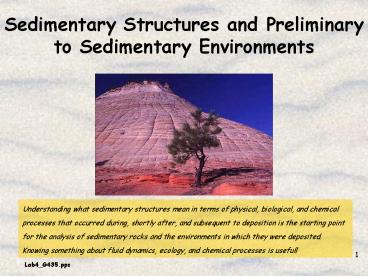Sedimentary Structures and Preliminary to Sedimentary Environments - PowerPoint PPT Presentation
1 / 22
Title:
Sedimentary Structures and Preliminary to Sedimentary Environments
Description:
May (in conjunction with other facies characteristics) be indicative of Sedimentary Depositional Environment. Primary Current Induced structures. Biogenic Structures. – PowerPoint PPT presentation
Number of Views:544
Avg rating:3.0/5.0
Title: Sedimentary Structures and Preliminary to Sedimentary Environments
1
Sedimentary Structures and Preliminary to
Sedimentary Environments
- Understanding what sedimentary structures mean in
terms of physical, biological, and chemical
processes that occurred during, shortly after,
and subsequent to deposition is the starting
point for the analysis of sedimentary rocks and
the environments in which they were deposited.
Knowing something about fluid dynamics, ecology,
and chemical processes is useful!
2
Sedimentary Structures
- Features preserved in sedimentary strata that
indicate. - Physical,
- Biological, and.
- Chemical processes and conditions during and
after deposition. - May (in conjunction with other facies
characteristics) be indicative of Sedimentary
Depositional Environment. - Primary Current Induced structures.
- Biogenic Structures.
- Deformational Structures.
- Secondary Mineralization.
Mud cracks, clear indication of desiccation and
subaerial exposure prior to lithification
3
Sedimentary Depositional Environments
- Siliciclastic
- Short
- Long
- Carbonate
- Rimmed margins
- Ramps
- Platforms
4
Sedimentary Depositional Environments
5
Common Siliciclastic Stratigraphic Successions
- Vertical successions characterized by lithology,
associations and vertical arrangement of
sedimentary structures - Indicative of particular sedimentary depositional
environments - Autocyclicity stratigraphic variability inherent
to a particular depositional environment
6
Common Sedimentary Facies Associations in
Carbonate Dominated Environments
- Vertical successions characterized by lithology,
associations and vertical arrangement of
sedimentary structures - indicative of sedimentary depositional
environments - typically indicate shoaling or shallowing upwards
trends
7
Primary Current-Induced Sedimentary Structures
- Accretionary and Erosional
- Accretionary/Aggradational
- Physical, chemical, biological accumulation
- Bedding
- lithologic, textural, structural homogeneity
indicating discrete time intervals of essentially
constant (or constantly changing) deposition - Vertical accretion parallel horizontal layers
- Lateral accretion
8
Primary Current-Induced Sedimentary Structures
- Bedding
- lithologic, textural, structural homogeneity
indicating discrete time intervals of essentially
constant (or constantly changing) deposition
- Vertical accretion parallel, horizontal layers
- Typically suspension settling/chemical
aggradation - Lateral accretion Traction transport
- Beds gt 1cm
- Laminations lt 1cm
9
Primary Current-Induced Sedimentary Structures
- Erosional (scour)
- Sediment removal by currents
- Bedding contacts
- Change in depositional regime
- Sharp------gt gradational-------gt amalgamated
- Bedding planes
- Non-deposition, erosion, or change in
depositional regime - Note the time significance of non-deposited
strata - Sedimentary record is sparse More time, with NO
deposition, than record.
10
Primary Current-Induced Sedimentary Structures
- Types of bedding (mechanical aggradation)
- Suspension settling vertical accretion
- Horizontal stratification
- Graded bedding
- Regular variation in particle size in an
individual bed (constantly changing hydrodynamic
conditions)
11
Primary Current-Induced Sedimentary Structures
- Types of bedding (mechanical aggradation)
- Traction lateral accretion from bed load
- Cross stratification
- Scale
- Cross laminations lt 3cm amplitude, lt 40 cm ?
- Cross beds gt 10cm amplitude, gt 10cm ?
- Planar tabular cross Strat vs trough cross Strat
12
Primary Current-Induced Sedimentary Structures
- Types of bedding (mechanical aggradation)
- Traction lateral accretion from bed load
- Cross stratification
- Scale
- Cross laminations lt 3cm amplitude, lt 40 cm ?
- Cross beds gt 10cm amplitude, gt 10cm ?
- Planar tabular cross Strat vs trough cross Strat
Climbing ripples
Planar-tabular x-beds
trough x-beds
13
Deformational Sedimentary Structures
- Desiccation
- Mud cracks (subaerial exposure), synaeresis
cracks (concentration gradients) - Water escape
- Mechanical instability (rapid deposition, high
water content)
14
Biogenic Sedimentary Structures
- Syndepositional modification of sediment by
biological agents. - Ethological approach (environmental conditions
determine organisms behavior gt sedimentary
record). - Biogenic structures influenced by
- Abundance of life.
- Types of organisms (plants, animals Single/
multicellular etc). - Mode of living.
15
Biogenic Structures Mode of Living
- Discrete burrows
- Form and shape
- Vertical escape artists Skolithos
- Horizontal grazers Zoophycus/Nereites
- 3D miners Cruziana
- Glossifungites
- Hard-rock miners burrows into firm substrate
- Through-going bioturbation
- Obliteration of primary current induced
structures indicates relatively slow rates of
sediment accumulation - Plant rootsgt subaerial deposition
16
Biogenic Structures Mode of Living
- Discrete burrows
- Form and shape
- Vertical escape artists Skolithos
- Horizontal grazers Zoophycus/Nereites
- 3D miners Cruziana
17
Biogenic Structures Mode of Living
- Discrete burrows
- Form and shape
- Vertical escape artists Skolithos
- Horizontal grazers Zoophycus/Nereites
- 3D miners Cruziana
- Glossifungites
- Hard-rock miners burrows into firm substrate
18
Biogenic Structures Mode of Living
- Through-going bioturbation
- Obliteration of primary current induced
structures indicates relatively slow rates of
sediment accumulation - Plant rootsgt subaerial deposition
19
Secondary Mineralization
- Typically indicate post-depositional geochemical
conditions - May indicate syndepositional geochemistry
- Concretions
- Localized mineralization due to concentration
gradients/variable geochemical microenvironments - Veining
- Primary texture induced concentration gradients
and mineral precipitation - Liesegang banding
- Stylolites
- Pressure induced differential mineral dissolution
20
Secondary Mineralization
- Concretions
- Localized mineralization due to concentration
gradients/variable geochemical microenvironments
21
Secondary Mineralization
- Veining
- Primary texture induced concentration gradients
and mineral precipitation - Liesegang banding
22
Secondary Mineralization
- Stylolites
- Pressure induced differential mineral dissolution































